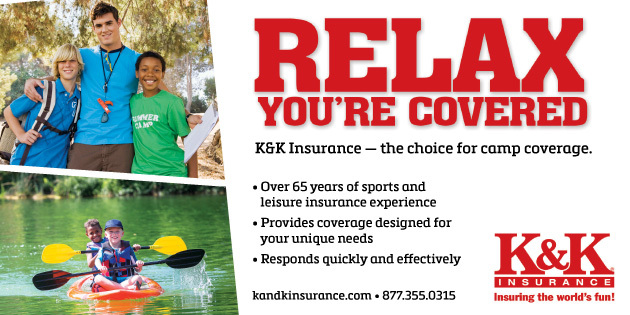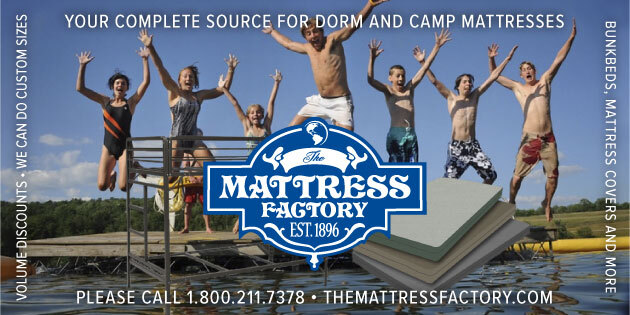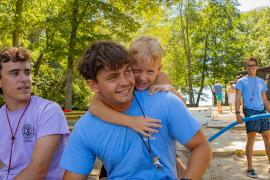We all know that camp is a character-building bonanza for young people, instilling lifelong skills that translate into future careers and perseverance through difficult times — all in a fun outdoor environment. But camp could be even more. John Judge, president and CEO of the Appalachian Mountain Club (AMC), says, “Children and teenagers are also capable of being fantastic outdoor stewards . . ..”
We recently spoke with Judge about his book The Outdoor Citizen: Get Out, Give Back, Get Active, an action plan for reconnecting with and advocating for nature. Says Judge: “We are not just citizens of our cities, states, and countries, we are citizens of the natural world, and we are identical in this. It is a citizenship each of us is born with, and one that allows us advantages but also gives us responsibilities.”
Tell us a little bit about yourself. What is your background and how did you come to feel the way you do about the outdoors and the environment?
My father was a Marine and a landscape architect. He got my sisters and me outdoors quite a bit. Tending to the outdoors was a big part of my upbringing and gives me joy to this day. My dad was ahead of his time in terms of conservation, recycling, composting, etc. I joined the Boy Scouts and became an Eagle Scout. That was an important learning time for me — including outdoor skills and leadership development.
Explain your concept of the “Outdoor Citizen.”
The concept of outdoor citizenship was crafted to think about how all of us participate wholeheartedly in both the benefits and the responsibilities of the outdoors. Being an Outdoor Citizen is both being active in outdoor recreation and outdoor pursuits (like gardening, for instance) while also being engaged in a personal stewardship of the outdoors and nature. Outdoor citizenship is everyone’s citizenship — open to all. And with nature as the human race’s common denominator, there’s an imperative for each of us to contribute as outdoor citizens.
You say that children and teenagers are capable of being fantastic outdoor stewards, and we should excite them with experiential, immersive, and high-quality outdoor-centric programs. That sounds a lot like summer camp. How do you think summer camps can best act as agents for change in teaching young people outdoor leadership skills?
I was so fortunate to both attend summer camps as a kid and later run summer camps as an adult. I’m a believer that the experiences a child has at summer camp are foundational to their development. Summer camps that approach things with a balance are successful — summer camp with personal discovery, group activities, experiential learning, and leadership opportunities.
You make some surprising connections between technology and the natural world, advocating the embrace of technology to protect the world’s natural assets. Can you explain what you mean and offer some examples?
Time spent away from computers is, of course, urgently needed. The awe of the outdoors and nature trumps technology any day. But getting us — kids and adults — away from screens and into the outdoors/nature is one of today’s biggest challenges. Once in nature, though, one becomes engaged and curiosities are awakened. A light weave of technology is almost an expectation for folks today. Citizen science is a great way to engage people in the outdoors and empowers them to protect our natural assets. iNaturalist, for instance, is a wonderful platform where one can help contribute to a body of conservation or nature research. It’s an easy app that can be downloaded and brought along with you on any of your outdoor excursions. Maybe you contribute to a phenology study and help scientists measure the changes in nature, or maybe you participate in the Dragon Fly Mercury Project — now in 140 national parks and run by AMC’s director of conservation research — where folks are trained to collect dragon fly eggs and then they are measured for mercury to identify mercury poisoning in streams or other bodies of water. Using technology to both learn about nature and “gamify” one’s experience fosters engagement and sustainability in one’s involvement.
You mentioned that according to the Outdoor Foundation’s 2018 Outdoor Participation Report, a study of 69.8 million Americans revealed that 54 percent of them were content not participating in outdoor activities at all. What do you think we have to do to change that mindset?
It’s a sobering statistic, however I’m convinced that it’s changed for the better during the COVID-19 lockdown time. More folks are getting outdoors. Sometimes it’s just in a backyard, but they’re at least getting outside. One of the foundational pieces for anyone is having one or two outdoor activities that are real passions. I have friends, for instance, whose whole family is pursuing their “New Hampshire 4,000 footers.” People are hiking the highest 48 peaks in New Hampshire, all over 4,000 feet. It’s a fun way to get outdoors and drives folks from an achievement standpoint. The key, however, is to start out simply and learn what you like — paddling, cycling, volunteer trail work, etc. Taking some introductory programs is a good way to hear from the experts and help set you up for success. There’s nothing like a few positive formative experiences to help change one’s mindset. I’d also recommend something you can do regularly without a lot of travel or expense. You might love mountain climbing, for instance, but if it’s tough to get to the climbing areas it will inhibit your regular participation.
You call the outdoors “one of the last bastions for digital detachment,” and said, “It is particularly critical that we steer the ship toward a predetermined digital future.” What digital future are you envisioning? And how can it work in tandem with nature?
Artificial intelligence, artificial reality, augmented reality, and the Internet of Things are just a few of the technologies that will be growing to underpin the functioning world around us. I talk about becoming an Outdoor City or an Outdoor Community. It’s important to prioritize the outdoors in all planning — to lay the ground rules for technology so it’s not running us, but rather supports our goals. Much like a city or town has a zoning code (a code that guides development of housing and other planning), we need an Outdoor City framework that certainly can lean on digital but doesn’t get usurped by it. It might be analogous to how digital technologies are influencing the art field now. We don’t want people to give up on oil painting or sculpture and pivot to using a computer stylus all the time or have artificial intelligence direct their creative process, but technology can certainly be helpful to an artist in selling one’s artwork online, creating a fan base on social media, etc. As communities become more dependent on technology — including to deploy smart city-type solutions or to collect and use prodigious amounts of data — nature and the outdoors will also be dependent on technology. I call this the “next ecology,” where we can use smart city-type applications to support the health and vitality of our natural world. A community’s ecosystem services, for instance, can be monitored by technology. How healthy are our marshes or how much water does a bioswale absorb after an extreme weather event? We can also use the next technological wave — the Fourth Industrial Revolution, per the World Economic Forum — to advance a new kind of citizen engagement in the care of nature. Imagine an app that pings your cell phone and lets you know to go down and water a neighborhood tree or solicits your help at a community volunteer event to rebuild a local bike trail. There will also be a number of latent apps that we will install on our cell phones that help each of us contribute to data collection. This might include data on how many folks are using a particular park or trail for collecting microclimate data.
Something else you said is that “Outdoor Citizenship provides purpose — it is a gateway to a more fulfilling life.” Can you elaborate on that statement?
Lately, I’ve had the chance to speak at colleges and universities and meet some of the students. Personal purpose and how one can make a contribution to the world comes up regularly. That’s a good sign for the future; it gives me hope. These young adults are asking, “How do I make a difference?” As an Outdoor Citizen, one really has a chance to build upon experiences and contribute to the greater good. We are at the intersection of so many challenges today, and I’m a firm believer that Outdoor Citizenship speaks to some of those challenges. There are so many ways one can use their outdoor citizen lens to not only help to maintain a local park or walking trail, but to speak out and act on so many other issues and challenges today. Examples include speaking up and acting on environmental policy or for social justice; organizing local volunteer opportunities in conservation areas; contributing to climate change data collection; or sharing best practices on outdoor recreation with people in other cities or towns around the world.
Sometimes the idea of “being the change” when it comes to protecting the natural world feels very daunting. What would you say to young people about that? Are there small steps they personally can take today that will make a big difference down the road?
Starting out very simply is key. Take four pieces of paper out. On the first one, write what you’d like to do during the next 90 days. On the second one, write out where you’d like to be in terms of your outdoor citizenship and contribution to the natural world in a year. On the third piece of paper sketch out where you’d like to be in five years — maybe serving on the board of a local conservation organization or completing training as a naturalist or outdoor guide. The fourth piece of paper can be reserved for your big goals and a longer-term vision. Maybe this includes becoming a great hike leader. So ask yourself, “What does that look like longer term?” I think keeping these goals in your nightstand or desk and referring to them from time to time is good. Keep iterating too — things change, and your interests may change along the way.
I want to circle back to summer camps. Both overnight camps in remote wooded areas and day camps in very urban areas are staunch supporters of outdoor experiential learning. What would you add to their conversation? Are there new ways you think camps could contribute to creating Outdoor Citizens among their staff and camper populations?
I would say the onus is on camps to lay out an active foundation for each camper to be an outdoor citizen while at camp, and then use outdoor citizenship as a way to keep people engaged in your community after camp closes for the summer. Everyone who has an experience with you — whether it be the day camp or the backcountry adventure — is an alum of your camp. Why not try to keep those folks engaged year-round? I’m talking about more than just “friending” a Facebook page, but rather a consistent and relevant engagement around outdoor citizen goals — personal goals for each person and community goals for the camp as a whole.
You also said, “The most effective way to keep people regularly returning to the outdoors is to make sure fun is a foundation of their outdoor time,” right?
Yes, keeping it fun is rule number one. We humans love to learn, network, work, give, and more when we can make it a fun experience. Being an Outdoor Citizen is first and foremost fun. Sure, the responsibilities of outdoor citizenship are real and serious — like stepping up and doing one’s own work to battle climate change — but that doesn’t mean the work can’t be enjoyable. There’s so much to do and experience solo or with family or friends, and keeping it fun will also help you to sustain your outdoor citizenship.




